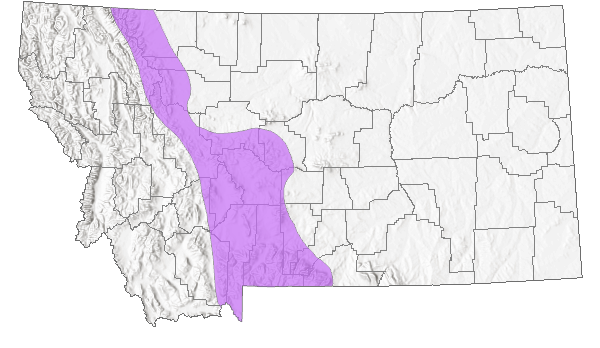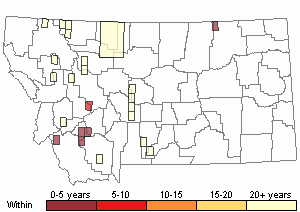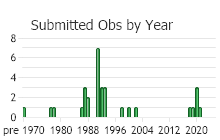View in other NatureServe Network Field Guides
NatureServe
Montana
Utah
Wyoming
Idaho
Wisconsin
British Columbia
South Carolina
Yukon
California
New York
Parry's Oatgrass - Danthonia parryi
Native Species
Global Rank:
G5
State Rank:
S3S4
(see State Rank Reason below)
C-value:
Agency Status
USFWS:
USFS:
BLM:
External Links
State Rank Reason (see State Rank above)
Danthonia parryi is endemic to western North America (FNA 2003). Parry's oatgrass is considered to be a major component of grasslands on the eastern foothills of the Rocky Mountains. In Montana it is considered to be fairly common along the Rocky Mountain Front and is reported for the Greater Yellowstone Ecosystem (FNA 2003), yet there are relatively few documented occurrences. This grass could be under-collected and/or easily misidentified. Current information on locations, population sizes, and threats is needed.
- Details on Status Ranking and Review
Range Extent
ScoreE - 5,000-20,000 sq km (~2,000-8,000 sq mi)
Area of Occupancy
ScoreD - 6-25 4-km2 grid cells
Number of Populations
ScoreB - 6 - 20
Number of Occurrences or Percent Area with Good Viability / Ecological Integrity
ScoreC - Few (4-12) occurrences with excellent or good viability or ecological integrity
Environmental Specificity
ScoreC - Moderate. Generalist or community with some key requirements scarce
Threats
ScoreD - Low
CommentNo known threats.
General Description
PLANTS: A herbaceous, perennial grass with culms of 30–70 cm in height.
LEAVES: Blades are 2–3 mm wide with essentially hairless sheaths, hairy collars (typically), and ligules of 0.5–1 mm length (Lesica et al. 2012).
INFLORESCENCE: A contracted panicle or raceme of 3–7 cm length with 4 to 10 spikelets. Spikelets are 17–22 mm long with 4 to 6 florets. Lemmas are tightly enfolded by glumes of 7–10 mm length, long-hairy over the entire back, and with awns 12–14 mm length (Lesica et al. 2012). It rarely produces grain (fruits or caryopses) in the terminal inflorescence (FNA 2003).
Species Range
Montana Range
Range Descriptions

 Native
Native
Range Comments
AK south to SK and NM (Lavin in Lesica et al. 2012. Manual of Montana Vascular Plants. BRIT Press. Fort Worth, TX).
Observations in Montana Natural Heritage Program Database
Number of Observations: 36
(Click on the following maps and charts to see full sized version)
Map Help and Descriptions
Relative Density

Recency



 (Observations spanning multiple months or years are excluded from time charts)
(Observations spanning multiple months or years are excluded from time charts)
Habitat
Dry mountain meadows (Lesica et al. 2012). Open grassland, open woods, and rock slopes at elevations up to 4,000 meters (FNA 2003).
Reproductive Characteristics
It is speculated that Danthonia parryi may have been derived from hybridization between Danthonia californica and Danthonia intermedia because it has intermediate morphology and rarely produces fruit (grain) in the terminal inflorescence (FNA 2003).
Stewardship Responsibility
References
- Literature Cited AboveLegend:
 View Online Publication
View Online Publication Flora of North America Editorial Committee. 2003. Flora of North America North of Mexico. Vol. 25. Magnoliophyta: Commelinidae (in part): Poaceae, part 2. Oxford Univ. Press, New York. xxv + 781 pp.
Flora of North America Editorial Committee. 2003. Flora of North America North of Mexico. Vol. 25. Magnoliophyta: Commelinidae (in part): Poaceae, part 2. Oxford Univ. Press, New York. xxv + 781 pp. Lesica, P., M.T. Lavin, and P.F. Stickney. 2012. Manual of Montana Vascular Plants. Fort Worth, TX: BRIT Press. viii + 771 p.
Lesica, P., M.T. Lavin, and P.F. Stickney. 2012. Manual of Montana Vascular Plants. Fort Worth, TX: BRIT Press. viii + 771 p.
- Additional ReferencesLegend:
 View Online Publication
View Online Publication
Do you know of a citation we're missing? Lesica, P., M.T. Lavin, and P.F. Stickney. 2022. Manual of Montana Vascular Plants, Second Edition. Fort Worth, TX: BRIT Press. viii + 779 p.
Lesica, P., M.T. Lavin, and P.F. Stickney. 2022. Manual of Montana Vascular Plants, Second Edition. Fort Worth, TX: BRIT Press. viii + 779 p.
- Web Search Engines for Articles on "Parry's Oatgrass"





